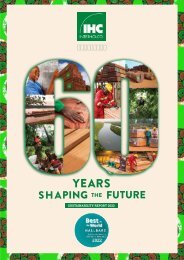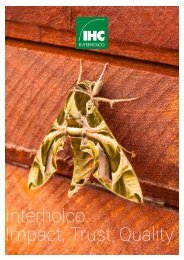Nomenclature Générale des Bois Tropicaux - 7ème édition
(english description below) Cette nomenclature est utilisée pour la mise à jour du 'Harmonized Code System' de l’Organisation Mondiale des Douanes. Dans la circulaire du 5 avril 2005, le Ministère de l’Economie, des Finances et de l’Industrie (France) reconnaît l’ATIBT comme « gardien du temple » de la nomenclature des bois tropicaux. La Commission Européenne mentionne la nomenclature de l’ATIBT comme document de référence pour la mise en œuvre du RBUE. Depuis 1954, l’ATIBT a établi et mis à jour une nomenclature des bois tropicaux faisant correspondre chaque espèce botanique avec un nom pilote reconnu internationalement. La détermination du nom pilote d’une essence est cruciale, car sa commercialisation dépend très largement de l’adoption de ce nom par le public. Le nom pilote assure la protection de l’appellation commerciale de l’essence et l’intégrité des propriétés qui lui sont attribuées, sans risque de confusion. The 1982 version of the general timber nomenclature has finally been updated as some of the 1,750 identified species, are no longer traded, while others, which were not previously included, are now on the market. The present revision has also integrated changes related to new taxonomy, in order to reflect the latest scientific developments. This Nomenclature has been used for the Harmonized Code System, updated by the World Customs Organization. The French Ministry of economy, finance and industry has given official recognition to ATIBT as the reference for the tropical timber nomenclature (NOR: PRMX0508285C of April 5th 2005). The European Commission refers to ATIBT nomenclature as a reference document for the implementation of the EUTR regulation. Since 1954, ATIBT has established and updated a nomenclature of tropical wood, linking each botanical species with an internationally recognized pilot name. A sigle wood species may have many common names; when trading across different countries, this may lead to confusion. Fixing the pilot name of a timber species is crucial, to protect the commercial denomination of the species and guarantee the veracity of the properties linked to that species, without confusion.
(english description below)
Cette nomenclature est utilisée pour la mise à jour du 'Harmonized Code System' de l’Organisation Mondiale des Douanes. Dans la circulaire du 5 avril 2005, le Ministère de l’Economie, des Finances et de l’Industrie (France) reconnaît l’ATIBT comme « gardien du temple » de la nomenclature des bois tropicaux. La Commission Européenne mentionne la nomenclature de l’ATIBT comme document de référence pour la mise en œuvre du RBUE.
Depuis 1954, l’ATIBT a établi et mis à jour une nomenclature des bois tropicaux faisant correspondre chaque espèce botanique avec un nom pilote reconnu internationalement. La détermination du nom pilote d’une essence est cruciale, car sa commercialisation dépend très largement de l’adoption de ce nom par le public. Le nom pilote assure la protection de l’appellation commerciale de l’essence et l’intégrité des propriétés qui lui sont attribuées, sans risque de confusion.
The 1982 version of the general timber nomenclature has finally been updated as some of the 1,750 identified species, are no longer traded, while others, which were not previously included, are now on the market. The present revision has also integrated changes related to new taxonomy, in order to reflect the latest scientific developments.
This Nomenclature has been used for the Harmonized Code System, updated by the World Customs Organization. The French Ministry of economy, finance and industry has given official recognition to ATIBT as the reference for the tropical timber nomenclature (NOR: PRMX0508285C of April 5th 2005). The European Commission refers to ATIBT nomenclature as a reference document for the implementation of the EUTR regulation.
Since 1954, ATIBT has established and updated a nomenclature of tropical wood, linking each botanical species with an internationally recognized pilot name. A sigle wood species may have many common names; when trading across different countries, this may lead to confusion. Fixing the pilot name of a timber species is crucial, to protect the commercial denomination of the species and guarantee the veracity of the properties linked to that species, without confusion.
Create successful ePaper yourself
Turn your PDF publications into a flip-book with our unique Google optimized e-Paper software.
32 ///
Nomenclature générale des bois tropicaux 2016
NOM BOTANIQUE
BOTANICAL NAME
FAMILLE
FAMILY
CONTI-
NENT
Lebrunia bushaie Staner Calophyllaceae AF Busehi
Lecomtedoxa klaineana Pierre Sapotaceae AF Oguomo
Lecythis spp. Lecythidaceae AM Sapucaia
Letestua durissima Lecomte Sapotaceae AF Congotali
Libidibia corymbosa Britt. & Killip (cf. Caesalpinia
paipai)
Libidibia sclerocarpa Britt. & Rose (cf. Caesalpinia
sclerocarpa)
Leguminosae (Caesalpiniaceae) AM Bridalveil
Leguminosae (Caesalpiniaceae) AM Ebano
Licania spp. Chrysobalanaceae AM Grigri
Licania canescens Benoist Chrysobalanaceae AM Grigri
Licania heteromorpha Benth. Chrysobalanaceae AM Grigri
Licania majuscula Sagot Chrysobalanaceae AM Grigri
Licania mollis Benth. Chrysobalanaceae AM Grigri
Licania rigida Benth. Chrysobalanaceae AM Grigri
NOM PILOTE
PILOT NAME
Licaria canella Kosterm. Lauraceae AM Kaneelhart
Licaria cayennensis Kosterm. Lauraceae AM Kaneelhart
Liquidambar formosana Hance Hamamelidaceae AS Thâu
Lithocarpus spp. (AS) Fagaceae AS Mempening
Lithocarpus celebicus L. Rehder Fagaceae AS Mempening
Lithocarpus elegans Hatus. Fagaceae AS Mempening
Lithocarpus sundaicus Rehder Fagaceae AS Mempening
Litsea spp. Lauraceae AS Medang
Lophira alata Banks Ochnaceae AF Azobé
Lophira procera A. Chev. (cf. L.alata) Ochnaceae AF Azobé
Lophopetalum spp. Celastraceae AS Perupok
Lophopetalum javanum Turcz. Celastraceae AS Perupok
Lophopetalum multinervium Ridl. Celastraceae AS Perupok
Lophopetalum wightianum Arn. Celastraceae AS Perupok
Lovoa klaineana Pierre (cf. Lovoa trichilioides) Meliaceae AF Dibétou
Lovoa swynnertonii Baker Meliaceae AF Dibétou
Lovoa trichilioides Harms Meliaceae AF Dibétou
Lysiloma latisiliquum Benth. Leguminosae (Fabaceae) AM Sabicu
Machaerium scleroxylon Tul. Leguminosae (Fabaceae) AM Rosewood, Caviuna
Maclura tinctoria D. Don Moraceae AM Moral
Macrolobium spp. Leguminosae (Caesalpiniaceae) AM Arapari
Macrolobium bifolium Pers. Leguminosae (Caesalpiniaceae) AM Arapari
Macrolobium brevense Ducke Leguminosae (Caesalpiniaceae) AM Arapari
Macrolobium multijugum Benth. Leguminosae (Caesalpiniaceae) AM Arapari
Macrolobium dewevrei De Wild. (cf. Gilbertiodendron
dewevrei)
Leguminosae (Caesalpiniaceae) AF Limbali
Madhuca p.p. Sapotaceae AS Nyatoh
Madhuca p.p. Sapotaceae AS Bitis














